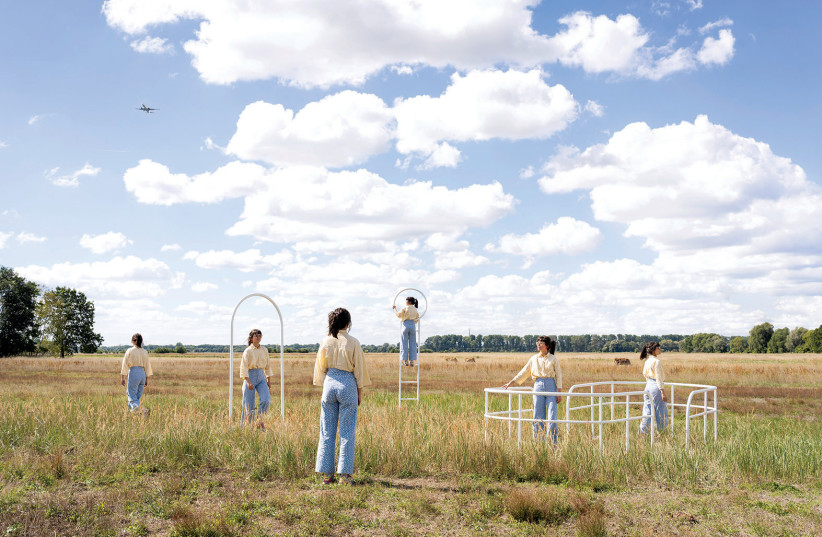“Lies & Falsehoods” isn’t a bad header for a cultural event these days. In an era of fake news, of politicians dispensing all manner of “factual” declarations designed solely to serve their personal interests – not that there’s much new there, it’s just that the hi-tech means for dissemination are now more efficient – it is intriguing to see the Jerusalem Design Week take up the theme and run with it.
With a debutant curatorial team in place, the festival was always likely to venture into previously uncharted areas. And so it has come to be. This year’s bash, the 12th edition, takes place at its regular berth in the majestic, evocative building and sprawling grounds of Hansen House (June 22-29).
The incoming curators Sonja Olitsky and Dana Benshalom, together with artistic director Dr. Jeremy Fogel have struck out for new aesthetic vistas across a broad sweep of exhibitions by Israeli and foreign artists, along with installations of various kinds and a host of performances.
Artistic exhibits in Jerusalem showcasing lies and facts
In their program notes, Olitsky and Benshalom state, unequivocally, that since time immemorial we have had our work cut out for us to discern the truth from all the noise around it tailored to deceive, even when we had it good.
“The lying and deceiving serpent was with us as early as Eden,” they write, “and continues to whisper in our ears even now – long after we were cast out. Lies and falsehoods have accompanied us since the dawn of history, if not earlier, as evident by the numerous trickster gods and deceitful spirits of the ancient world: Loki in Norse mythology, Anansi in the tales of the Ashanti people of West Africa, the Monkey King Sun Wukong in Chinese mythology, Iktomi in the traditions of the Lakota tribe of the great plains of North America, and others.”


That is quite a cast of mighty characters, across an expansive cultural, geographic and temporal spectrum. But how is popping along to Hansen House supposed to lift the veil of vested propaganda interests from our bewildered eyes?
Surely, the very word “design” suggests the existence of an agenda, an intent to lead us by the nose to some preconceived end game, calculated to deliver some (commercial or other) gain. The curators are aware of the dichotomous element inherent in the profession.
“The designer’s work oscillates between reality and fiction. On the one hand, there is the constant expectation to produce a dazzling spectacle, the constant longing for beauty, and the impetus to generate desire in order to maximize profits.”
No surprises there but, it seems, healthier dynamics are afoot.
“On the other hand, current design practices have been focusing more and more on establishing transparency, building trust and taking responsibility. Is the act of design fundamentally a manipulative concealment of truth? Can it help promote transparency, honesty and authenticity? And if so, how?”
The event at Hansen House may shed a little light on that, as per the curators’ declaration of programmatic intent.
“The 2023 Jerusalem Design Week sets out to examine and celebrate the designer’s role in these contexts through works that explore the importance of illusions by concealing, deceiving and creating parallel realities, as well as through works that deal with disclosure and honesty by examining the possibility of truth and authenticity in the face of widespread lies and falsehoods.”
That sounds like a tall order, but Olitsky and Benshalom have put in the requisite spadework. We may just come out of the eight-dayer with a little enlightenment and some good vibes.
Only time will tell on that score. Either way, Benshalom says she and her running partner are keenly aware of the size of the curatorial shoes they are entering and the need to keep the decade-plus momentum at full steam.
“This is a major event. Our job is to keep the energy going.”
This year’s theme seems a good way to go about that, particularly in an increasingly virtual age when people talk about “meeting” via Zoom and “chatting” via WhatsApp, not to mention the spread of “confluences” on social media. In the pre-digital world, meeting meant just that, actually and corporeally converging in the same geographic spot on Earth.
Miniaturization, Benshalom suggests, is also playing its part in directing us ever deeper into the non-human woods.
“The hierarchies of distribution have changed and, over the past two to three years, artificial intelligence has come into the picture, along with anything that fits into the interface between humans and machines.”
That instantly raised images of Charlie Chaplin’s prophetic 1936 movie Modern Times in which conveyor-belt workers were inexorably drawn into the machinery operational vortex.
Benshalom sees the connection with Chaplin’s apocalyptic vision but intimates that matters have deteriorated since then, with technological advances and dimensional downscaling.
“Back then machines were very large and robust, now they are a direct extension of our fingers. There is something in digitization that changes the rules of the game.”
For the old fogies – such as myself – who relate to the above terms of interpersonal interaction according to their original sense, this year’s Design Week program may provide some much-needed encouragement. It seems the younger folk, too, specifically the artists who contribute to next week’s agenda, are eager to reconnect with the tangible.
“When we sent out the call for proposals, we wondered whether we were only going to get submissions from technology and AI freaks,” says Olitsky. Happily, that was not the case.
“We received a very broad range of very interesting responses. We got ideas where design relates to the human body.”
One such is “Body of Knowledge, Human Body” courtesy of a nonet designer team which includes Tidhar Zagagi, Niv Fridman, Daniel Paul and Efi Kishon. The informational backdrop to the work references the recent pandemic and how, even with the race for technological progress still well and truly on, Zagagi works on the basis of the – still – incontrovertible fact that we are physical entities, regardless of how many hours a day we spend in front of our computer or cell phone screens “meeting” each other or, for that matter, any number of plastic surgery interventions we undertake in order to maintain the illusion of agelessness.
“Humankind is currently trapped in a curious conflict surrounding its physicality,” says Zagagi.
“On the one hand, despite our best efforts, we are still very much physical beings – some would even say, too physical. Our bodies are transient. Tiny biological molecules can still infect us with diseases, spread uncontrollably, and turn our world upside down,” he notes with a clear nod to the virus that recently did the global rounds.
“We still age, and eventually, as our body withers, we die. At the same time, we are in the midst of an unprecedented race for preserving our youthfulness: an ongoing technological effort that will continue to produce better and better results, perhaps to the point of defeating death through science. Meanwhile, as our digital presence also intensifies, the boundary between us and the technologies that interface with our bodies becomes more and more permeable.”
Does that suggest a blurring of the lines between us and the “golems” we continue to create and perfect?
“What is the connection between the human body and the body of knowledge that enables these advancements? How does our physicality change when we strive to overcome it? And if we look better, younger, and more attractive behind filters, why would we ever want to go out into the world in these grotesque bodies of ours?”
That is a terrifying prospect as we continue to nurture a revenue-generating image of what constitutes “beauty.”
“Body of Knowledge, Human Body” addresses that concerning conundrum head-on.
“The collection of works on view in this space unfolds diverse perspectives on the human body as the object of lies and falsehoods and as an irrefutable truth (at least for now),” the project catalog explains.
“Some wish to design and improve the body, some contemplate its past or try to predict its future, while others offer a disturbing image of the present.” Now that’s a meal and a half for thought.
But, thankfully, it’s not all doom and gloom and dystopian scenarios. The “WoodenWood” venture, for example, explores ways to recycle and reuse the titular raw material and, even, “the potential to replace petroleum-based materials in design applications and reduce large amounts of wood waste from agriculture, municipal and industrial sites.”
“This is an example of an attempt to emulate the technique of basketwork, by means of 3D printing. This is a very interesting technique which these designers recently exhibited in Milan.”
Jerusalem Design Week has become a major fixture here since its inception in 2011. It has provided a supportive platform for local talent and has also begun to attract attention from abroad. This year’s lineup includes a number of offshore designer teams, such as the 24-member multinational, interdisciplinary “Typomania” team with its Black & White, Now creation.
As its leading creators Alexander Vasin and Natalia Velchinskaya note, the work references the ongoing war in Ukraine.
This, they say, is a matter of facing up to the cold hard realities of life, and looking for possible solutions in aesthetics.
“This ongoing disaster raises questions we cannot but ask ourselves: What can the role of design be in times of such savagery? Is the world now divided into black and white, or do we still need the shades in between? The “Typomania” project has invited 24 designers, calligraphers and illustrators to answer the latter question through a series of posters that are displayed on the windows on one of the outer walls of the Hansen House.”
Turkey is also present in the Design Week programmatic mix, with the Nohlab group from Istanbul turning the upper floor of the host venue into a parallel world with its In-line V2 animation and sound creation, while the MEATS Elisava quartet from the Barcelona School of Design and Engineering gives the inner yard a hi-tech makeover with the Llacuna light and mist combo.
With contributions from numerous players in the local arts and design sector too, such as HIT, Shenkar, and Bezalel – as well as an extensive span of independent designers – Jerusalem Design Week appears to proffer quite a few reasons to be cheerful. ❖
For more information: www.jdw.co.il












